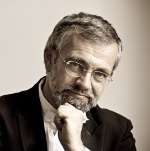The Sydney Symphony Orchestra was kept busy this week. Together with their acclaimed soloist, cellist Daniel Müller-Schott, they performed (almost) the same program four times within a 50-hour time span. In three of those concerts, the opening number was Burnout by Holly Harrison, another new composition in the 50 Fanfares Commission. Although many composers in this ongoing series of freshly generated Australian works elected to write for large ensembles, typically a full orchestra, this work was conceived with ten brass players from the orchestra in mind. It was a genuine fanfare, motivated by revving-engines and passing supercars. The jazz-inspired cross-rhythms posed no problem to the players, however, clear articulation in the virtuosic fast passages in some places felt overly demanding.
Antonín Dvořák’s Cello Concerto in B minor never fails to attract lovers of lush Bohemian melodies and ecstatically buoyant sentiments and the audience’s response was accordingly enthusiastic after the German star cellist’s performance. No wonder, for Müller-Schott is a highly likeable artist with a pleasing stage presence and an impeccable technique. In his interpretation, he modified quite a few of Dvořák’s meticulously outlined dynamic and articulation instructions, yet his playing was always sincere and heartfelt. The most memorable moments were offered in some of the softer sections, for example at the beginning of the first movement’s development in the most unlikely key of A flat minor or in the slow movement's coda.
His elegant rubato style of playing was not always understood or perceptively followed by conductor Eduardo Strausser and, as a result, the orchestra’s accompaniment felt sluggish at times. An even greater problem, however, was that the joy of hearing Müller-Schott’s supremely confident solo was undermined by persistent problems of balance between his cultured but not huge tone projection and that of the orchestra. Some of this could be explained by acoustic reasons; after all, in a Romantic concerto the soloist needs to be heard over the collective playing of the accompanying 60-70 musicians and the sound of the cello is less powerful than that of a grand piano or even a higher instrument, such as the violin. Dvořák’s writing is expertly delicate though and his orchestral tuttis are consistently reduced in volume when the solo instrument enters. I would not blame the orchestra for the lost cello melodies either; in his enthusiasm, it was the conductor who seemed to remain oblivious to keeping his musicians at the necessary dynamic. Somewhat oddly (and this may be related to the specific acoustical environment of the hall), it was not the relatively large body of string players that tended to muffle the cello solo, but mostly the woodwinds and horns, sitting in the back of centre stage, otherwise playing impeccably.
Fortunately, matters improved considerably after interval, during the performance of a compilation of movements from the three Romeo and Juliet suites of Sergei Prokofiev. The nine chosen numbers loosely followed the familiar story of the star-crossed lovers and Prokofiev’s brilliant score found worthy exponents in the SSO and its much energised conductor. The sound of the enlarged orchestra was enriched by the sonic delight of some unusual tone colours, such as a saxophone, piano, celesta, harp and no less than six percussionists. Strausser mixed the contrasts with an assured hand and great musical taste between the majestic entrance of the Dance of the Five Couples, the orchestrally virtuosic Death of Tybalt, the lush, divided strings in Friar Laurence’s movement leading to the sublime last minutes in the young couple’s life, with which the concert ended.




